Commando Leopard aka Kommando Leopard (Dir Antonio Margheriti / Anthony M Dawson, 1985)
Basic plot: A group of freedom fighters, led by Carrasco, set out to destroy the dictatorship that rules their state.
Cast: Silveira – Klaus Kinski; Carrasco – Lewis Collins; Maria – Cristina Donadio; Padre Julio – Manfred Lehmann; Smithy – John Steiner; Capitan – Hans Leutenegger; José – Thomas Danneberg; Pater Miguel – Michael James; Homoza – Subas Herrera
Filming location: Maracaibo, Estado Zulia, Venezuela; Pagsanjan, Laguna, Philippines
Release date: 24 October 1985 (West Germany)
Availability: The DVD of Commando Leopard is readily available and I understand a new version is to be released by Arrow Films on 19 November 2012 (available to pre-order for just £6.99 here). I wonder if this new version will be a full length version as the running time for the film is listed as 103 minutes on IMDB, with a 100 minute edit in Norway. The Anchor Bay version I have runs to just 99 minutes though. The Anchor Bay version has a Making Of… featurette as a bonus feature, which has already been reviewed by me separately here. Very amusing it is, too! Note that on the Anchor Bay DVD the cover states that the soundtrack is provided by Ennio Morricone – it’s not; the Casio pan pipes sounds come courtesy of Goran Kuzminac.
The film – *SPOILER ALERT*:
I have been saying I will review this film since June this year when I reviewed the Making Of featurette and I have been procrastinating ever since. It has to be said that action films are not my cup of tea, at all – anyone who read my review of The Soldier will have gathered that. But I have watched Commando Leopard 3 or 4 times now to make notes and take screen grabs &c and so this review just has to be done so I can move on and put this nightmare behind me at last. Right then, let’s go for it!
The action starts on September 11th when there are big explosions aplenty – now I’m not saying that Antonio Margheriti was having a Powder Keg moment of precognition but he must surely have foreseen that there would be explosions on set at least. Between Klaus Kinski and someone; in this case Lewis Collins. Good job then that they were on the opposite sides of this civil war so they (or Klaus mainly) could take out their anger on each other during the filming as well as off-camera. No need to bottle it up, eh?
There’s plenty here for the action movie fans as immediately there is throat slashing and shooting with darts. Loads of low angle shots of a dam and people the viewer just doesn’t know. I don’t know if I’m supposed to be on their side because I don’t know who they are or what they are doing. Even by the end of the film I’m still not quite sure what’s happening, but I’m quibbling, aren’t I? Why should there be a narrative to follow when all you need to know is there are two groups fighting each other?
All the elements of action movies have been covered in Commando Leopard. Typically just 3 minutes in there is “a look” between Carrasco (Lewis Collins) and a character called Maria (Cristina Donadio) – yes, as ever, there is time for sexual tension even in the midst of a terribly violent civil war. There are tanks, tankers, barbed wire, abseiling down rocky cliff faces, machine guns, grenades, dynamite, choppers and explosions left, right and centre. Margheriti puts on a real show for us, but what actually happens? Like I said before I’m not entirely sure but I’ll take a pop at it and try to see if I can make any sense of it.
Carrasco is the leader of the rebels but he inexplicably has traces of a Merseyside accent and sometimes looks like he has been “blacked-up” a bit, mainly because he has. He’s not supposed to be from Merseyside, you see, he’s supposed to be (indeterminate) Latin American. This is a problem.
He is fighting against some dictatorship we’ve not yet been introduced to and he has to make tough decisions like whether or not to blow up a dam even if it means that innocent people downstream will die. Of course he blows up the dam because he sees it as being for the greater good of everyone else; some innocent people will die but it will help to put an end to the evil regime that is currently ruling them. He also manages to lose some men in a chopper explosion as well. Not sure how many of the “good folk” will be left by the end of the film, but it’s not looking like a good start, that’s for sure.
Add to this the Casio pan pipes music fading in and out, which just serves to make the film even more annoying (as far as I’m concerned at least).
Carrasco takes his men to see how things are on the other side of the mountain – it seems that what they really want is some food, water and a rest before they go on their way to fight some more. They don’t seem to care that they are effectively stealing the food and water from the villagers who have very little and they seem to see it as their right to take it anyway because they are fighting to save everyone from the evil regime. As far as I can see they are not that far removed from being an evil regime themselves, especially Smithy (John Steiner) who is rude and nasty and grasping. Smithy helps himself to some soup, which he eats like a pig. He’s told that it’s the kids’ supper and now they’ll have to go hungry but he carries on eating regardless. They’re going about all this the wrong way as far as I’m concerned and I’m proved right only moments later…
Yes, by going to the village Carrasco and his group of rebels have made the villagers part of the militia’s target; the militia are after Carrasco, of course, but if they have to attack an entire village to get Carrasco they will do it in the same way that Carrasco attacked the dam and killed civilians downstream. So thanks to Carrasco the entire village is set on fire and the villagers are gunned down by the Capitan (Hans Leutenegger, yay!) and his men. The rebels are doing so well, aren’t they?
During this attack some kid, who had earlier been befriending Maria in one of those “this has to be the heart-warming moment” in the film, sees his dad being shot repeatedly. You know Maria will take him with her and he’s going to end up joining the rebels even though he is only about 7 years old. Again, she probably thinks she is helping him and yet she is actually drawing him into the firing line.
The rebels don’t want their wounded slowing them down (they are nice like that) so Maria is sent off to a hospital to get treatment for them. Carrasco and Smithy and the other rebels will carry on without them. Just as well Maria has gone as she’s a woman and she would have slowed them down, what with her hair and make-up and shoes and that. She’s just a liability so let’s banish her, yeah?
Meanwhile the Capitan surveys the damage the militia have caused to the village and Silveira (Klaus Kinski) is called before the President to explain why the valley is full of militia men. The President is not very happy at all but Silveira just dismisses it all as “stupid propaganda”. We find out a little about Carrasco now as well – his father is one of the richest men in the country, who gave everything up to fight for the people. I don’t know what to make of that nugget. Silveira lights a huge cigar and tells the President if he is given more fuel and men that the rebels can be crushed. There are obvious tensions between Silveira and the President; maybe I’m going all precog on you now, but something tells me that this is not a very happy partnership.
If Silveira is dismissive of Carrasco (and he is – he tells the President that Carrasco is “like all the others; he wants your place”), he is equally dismissive of the President (whose place Silveira undoubtedly wants for himself). When the President is shown on TV making a speech to the people, Silveira turns the volume down because he’s just not interested in what the President has to say.
 Meantime Maria had been taking some behavioural lessons from the ever-charming Smithy – she’s arrived at the hospital, which has seen better days, and is demanding beds, antibiotics and surgical instruments at gunpoint. When she is told that there are only 2 beds free she starts dragging sick people out of their beds to make way for the wounded rebels. One of the Fathers who are working at the hospital tells Maria in no uncertain terms that she can’t be doing that and that as far as he’s concerned the rebels are just like the militia. Maybe this makes Maria think about her actions because there is a quick about-turn with Maria revealing that she was a medical student and diagnosing one of the hospitalised men as needing operating on immediately.
Meantime Maria had been taking some behavioural lessons from the ever-charming Smithy – she’s arrived at the hospital, which has seen better days, and is demanding beds, antibiotics and surgical instruments at gunpoint. When she is told that there are only 2 beds free she starts dragging sick people out of their beds to make way for the wounded rebels. One of the Fathers who are working at the hospital tells Maria in no uncertain terms that she can’t be doing that and that as far as he’s concerned the rebels are just like the militia. Maybe this makes Maria think about her actions because there is a quick about-turn with Maria revealing that she was a medical student and diagnosing one of the hospitalised men as needing operating on immediately.
 Whilst Maria springs into action in the hospital, the militia have heard news of where Carrasco’s gang are holed up, so it will only be a matter of time before another attack takes place. But Carrasco and Smithy are trying to put an end to the dictatorship by retrieving some explosives that were sunk during the dam explosion. They plan to do this by setting up a bomb with what looks like a bedside alarm clock and some putty. As they swim around underwater, you know it’s going to go wrong and indeed it does – the timing is out and Smithy suffers some injuries when one of the bombs goes off. Carrasco manages to get away with the help of some of his men but he has to leave Smithy behind as dead – remember, the rebels can’t let the wounded slow them down.
Whilst Maria springs into action in the hospital, the militia have heard news of where Carrasco’s gang are holed up, so it will only be a matter of time before another attack takes place. But Carrasco and Smithy are trying to put an end to the dictatorship by retrieving some explosives that were sunk during the dam explosion. They plan to do this by setting up a bomb with what looks like a bedside alarm clock and some putty. As they swim around underwater, you know it’s going to go wrong and indeed it does – the timing is out and Smithy suffers some injuries when one of the bombs goes off. Carrasco manages to get away with the help of some of his men but he has to leave Smithy behind as dead – remember, the rebels can’t let the wounded slow them down.

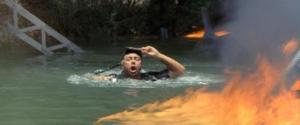 Another oblique insight into Carrasco’s back story – one of his men says to him, “If your father was here to see that…”, to which Carrasco responds, “He’d probably shoot me.” He also says that he was brought up believing that the rich came before the poor. I’m not quite sure what point he is making here as he seems to be behaving in such a way that says that the rebels come before the civilians who are not fighting; there’s not a lot of difference. These little snippets of information about Carrasco’s father do not help with the narrative development at all really.
Another oblique insight into Carrasco’s back story – one of his men says to him, “If your father was here to see that…”, to which Carrasco responds, “He’d probably shoot me.” He also says that he was brought up believing that the rich came before the poor. I’m not quite sure what point he is making here as he seems to be behaving in such a way that says that the rebels come before the civilians who are not fighting; there’s not a lot of difference. These little snippets of information about Carrasco’s father do not help with the narrative development at all really.
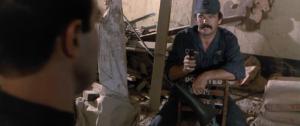
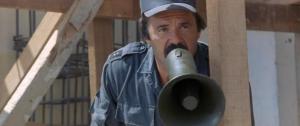 Back at the hospital Maria is pulling a blinder in her role as Florence Nightingale. She is so distracted with her medical work that she doesn’t even notice that the militia have arrived. The Capitan is there with his men and they want to know where the rebels are; Hans Leutenegger tries to act as mean as possible but you just know he’s a pussycat underneath it all. The Father tells Maria to stay inside but she insists on fighting for her beliefs – whatever they are – and goes outside only to get shot immediately. The Father runs out and they share one of those magic moments; a bit like “the look” she shared with Carrasco earlier. She’s a one, that Maria.
Back at the hospital Maria is pulling a blinder in her role as Florence Nightingale. She is so distracted with her medical work that she doesn’t even notice that the militia have arrived. The Capitan is there with his men and they want to know where the rebels are; Hans Leutenegger tries to act as mean as possible but you just know he’s a pussycat underneath it all. The Father tells Maria to stay inside but she insists on fighting for her beliefs – whatever they are – and goes outside only to get shot immediately. The Father runs out and they share one of those magic moments; a bit like “the look” she shared with Carrasco earlier. She’s a one, that Maria.
 Then the chopper arrives with Silveira onboard – now we know some real damage will be done, yay! Silveira does the rounds at the hospital, although he’s not so hot on the bedside manner – when one of the injured men shouts out to him, “Colonel! I’m one of yours!”, Silveira shows no sympathy and just mutters, “You let yourself be captured, uh?”, as he walks away. Same rules apply as with the rebels, I guess – “Don’t let the wounded slow you down.”
Then the chopper arrives with Silveira onboard – now we know some real damage will be done, yay! Silveira does the rounds at the hospital, although he’s not so hot on the bedside manner – when one of the injured men shouts out to him, “Colonel! I’m one of yours!”, Silveira shows no sympathy and just mutters, “You let yourself be captured, uh?”, as he walks away. Same rules apply as with the rebels, I guess – “Don’t let the wounded slow you down.”
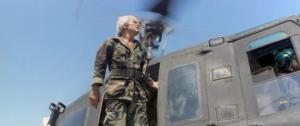
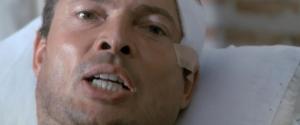
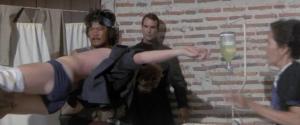 Silveira heads over to José, one of the injured rebels, and asks him if he was one of the technicians at the dam and if he knows who was in charge. Instead of acting dumb, José tells Silveira, “Find them yourself, you son of a bitch!” His last words, alas, as he is immediately shot to pieces by the militia. The Father tells Silveira to stop and gets a gun smacked around his face for his trouble – Silveira wants to take Maria and the Father but he also wants the hospital set on fire and all the equipment shot to pieces. He leaves the injured militia behind to perish in the fire as well.
Silveira heads over to José, one of the injured rebels, and asks him if he was one of the technicians at the dam and if he knows who was in charge. Instead of acting dumb, José tells Silveira, “Find them yourself, you son of a bitch!” His last words, alas, as he is immediately shot to pieces by the militia. The Father tells Silveira to stop and gets a gun smacked around his face for his trouble – Silveira wants to take Maria and the Father but he also wants the hospital set on fire and all the equipment shot to pieces. He leaves the injured militia behind to perish in the fire as well.
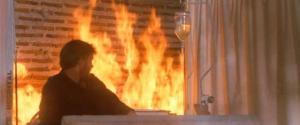
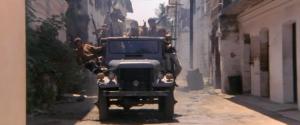 As Carrasco and his men arrive armed with guns, the Casio pan pipes kick in again. That’s enough to send Silveira and the Capitan back to their chopper in which they escape. Carrasco blows up a chopper, but it’s not Silveira’s. Maria and the Father have inadvertently been left behind and Carrasco goes over to see them. The Father asks Carrasco what he will do with the people now that the hospital has been attacked. Carrasco avoids answering and simply tells the Father that he should get his face wound looked at before it gets infected. The Father is right though, if the militia come back they will be massacred but all Carrasco says he can do is give them trucks to get away. When the Father says he will take the people with him instead, Carrasco is dismissive – “Where to? The Promised Land?” Got any better ideas yourself, Carrasco? No, thought not.
As Carrasco and his men arrive armed with guns, the Casio pan pipes kick in again. That’s enough to send Silveira and the Capitan back to their chopper in which they escape. Carrasco blows up a chopper, but it’s not Silveira’s. Maria and the Father have inadvertently been left behind and Carrasco goes over to see them. The Father asks Carrasco what he will do with the people now that the hospital has been attacked. Carrasco avoids answering and simply tells the Father that he should get his face wound looked at before it gets infected. The Father is right though, if the militia come back they will be massacred but all Carrasco says he can do is give them trucks to get away. When the Father says he will take the people with him instead, Carrasco is dismissive – “Where to? The Promised Land?” Got any better ideas yourself, Carrasco? No, thought not.
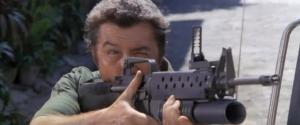 It’s now one week since the film started – I mean, since the action started; it just feels like the film’s been on a long time, that’s all. Nothing much has happened really but we now discover that Smithy survived the underwater blast after all and has been captured by the militia. He’s currently sitting naked on a chair and Silveira is looking at him through a barred window. Kinky!
It’s now one week since the film started – I mean, since the action started; it just feels like the film’s been on a long time, that’s all. Nothing much has happened really but we now discover that Smithy survived the underwater blast after all and has been captured by the militia. He’s currently sitting naked on a chair and Silveira is looking at him through a barred window. Kinky!
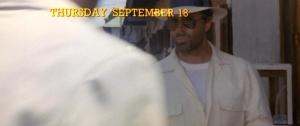 Carrasco has dressed up in civvies and gone into town to see a man about a dog – or something. A strange little man follows him around but Carrasco knows all about it and in the film’s (unfunny) comedy moment, Carrasco surprises the man by sticking a gun in his mouth which makes his eyes go all googly, look:
Carrasco has dressed up in civvies and gone into town to see a man about a dog – or something. A strange little man follows him around but Carrasco knows all about it and in the film’s (unfunny) comedy moment, Carrasco surprises the man by sticking a gun in his mouth which makes his eyes go all googly, look:
Carrasco wants to know where Pépé is – maybe I’m right after all and he is going to see a man about a dog, Pépé sounds like a dog’s name, right? But, no, Pépé is in fact a chap who thinks he can get Smithy and the others out of prison. It seems that Smithy is a famous mercenary brought back from Europe by Carrasco to join the rebels. The next day Smithy and his fellow inmates are broken out of the prison, one of them dies on the way out, but Smithy gets out intact.
Smithy has to pass Carrasco a message to say that President Homoza is planning a fact finding tour of the province on Thursday. This is the only bit of the film that makes me laugh because, no word of a lie, I had to rewind and watch this segment about 5 times before I realised that it was a “fact finding tour”; it sounded just like “fat fanny tour” to me (if you’ve got the Anchor Bay version of the film, go to 58 mins 15 secs and see what you think) which means something else altogether really.
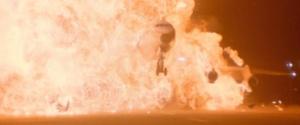
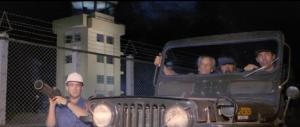 It’s now 2 weeks since the action started. Smithy is back with a couple of dubious looking new recruits – he goes with Carrasco and the new recruits to see Homoza. They are all hanging out at a landing field when suddenly one of the new recruits runs off as a plane lands. It seems that the new recruits were using Smithy to lure Carrasco into a trap. Carrasco shoots the man and then shoots at the plane believing that something untoward is about to happen. The plane explodes, which Carrasco believes he is responsible for, but in fact the plane has been shot down by Silveira’s men with a rocket launcher. Silveira drives off, believing that this incident will prove to be the end of Carrasco.
It’s now 2 weeks since the action started. Smithy is back with a couple of dubious looking new recruits – he goes with Carrasco and the new recruits to see Homoza. They are all hanging out at a landing field when suddenly one of the new recruits runs off as a plane lands. It seems that the new recruits were using Smithy to lure Carrasco into a trap. Carrasco shoots the man and then shoots at the plane believing that something untoward is about to happen. The plane explodes, which Carrasco believes he is responsible for, but in fact the plane has been shot down by Silveira’s men with a rocket launcher. Silveira drives off, believing that this incident will prove to be the end of Carrasco.
 Carrasco is shot and the Casio pan pipes kick in again – that’s adding insult to injury, that is.
Carrasco is shot and the Casio pan pipes kick in again – that’s adding insult to injury, that is.
Meantime the President is told that the plane, believed to have been shot down by the rebels, was carrying 185 children on their way back from adventure camps. That Silveira is a one! He thinks this will turn the people against Carrasco for sure and he’s now as good as dead. It certainly looks bad for him right now.
But they’re all a bit slow off the mark because it’s two weeks later when a chopper circulates propaganda to the people demanding that the rebels surrender. The Father sees the propaganda but he doesn’t believe that Carrasco would deliberately try and cause a disaster; he believes Silveira is somehow responsible. He’s right on that one.
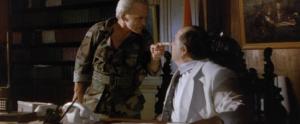 Silveira tells the President that the militia were responsible for the plane being shot down but this fails to impress the President because, as he points out, he could have been on the plane himself. Silveira is so annoyed with the President’s ungrateful attitude that he shakes his finger in the President’s face and tells him that he’s not afraid of him. The relationship is really deteriorating now…
Silveira tells the President that the militia were responsible for the plane being shot down but this fails to impress the President because, as he points out, he could have been on the plane himself. Silveira is so annoyed with the President’s ungrateful attitude that he shakes his finger in the President’s face and tells him that he’s not afraid of him. The relationship is really deteriorating now…
I’m not sure where he’s been all this time but Carrasco is back now and he’s injured from that shot he took about two weeks ago. Carrasco asks the Father for some help – he wants to destroy the refinery so the dictatorship would be finished and in return he will escort the people to the border. By now, of course, three-quarters of the rebels are gone so I’m not sure how Carrasco plans to do this, but I clearly know very little so just ignore me.
 By luck it would seem that the Father was the garrison chaplain at the refinery so the militia won’t be suspicious when he turns up there. The Father agrees to help Carrasco and as this part of the story unfolds it seems to me that the Father knows a bit too much about how to bring about utter destruction. The Father goes to the train station with Carrasco, now dressed as a Father too, and he drops a case of sacred objects to cause a distraction whilst Carrasco puts explosives on the train. The train driver knows the Father and insists on speaking with him, so the Father and Carrasco have to board. They are just being asked to present their papers, which will be a problem for Carrasco, when the train pulls into the refinery and the bombs go off. The Father and Carrasco jump off the train.
By luck it would seem that the Father was the garrison chaplain at the refinery so the militia won’t be suspicious when he turns up there. The Father agrees to help Carrasco and as this part of the story unfolds it seems to me that the Father knows a bit too much about how to bring about utter destruction. The Father goes to the train station with Carrasco, now dressed as a Father too, and he drops a case of sacred objects to cause a distraction whilst Carrasco puts explosives on the train. The train driver knows the Father and insists on speaking with him, so the Father and Carrasco have to board. They are just being asked to present their papers, which will be a problem for Carrasco, when the train pulls into the refinery and the bombs go off. The Father and Carrasco jump off the train.
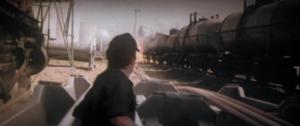
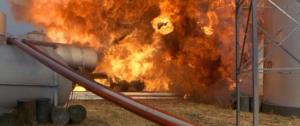 Silveira is still getting nowhere with the President – the tables are now turned and this time the President walks away from Silveira mid-sentence, dismissing his claims that Carrasco has now dug his own grave and that he will get Carrasco.
Silveira is still getting nowhere with the President – the tables are now turned and this time the President walks away from Silveira mid-sentence, dismissing his claims that Carrasco has now dug his own grave and that he will get Carrasco.
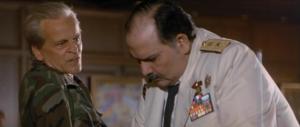
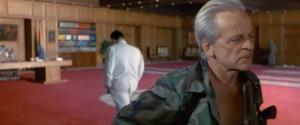 A few days later the Father leaves with the children on a bus, but unfortunately the bus is heading straight for some mine fields. Silveira is looking out to see if Carrasco is onboard but he’s not. Then the mines start to go off and the militia start shooting.
A few days later the Father leaves with the children on a bus, but unfortunately the bus is heading straight for some mine fields. Silveira is looking out to see if Carrasco is onboard but he’s not. Then the mines start to go off and the militia start shooting.
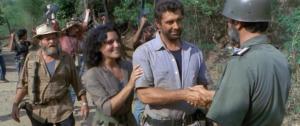 Carrasco and the rebels are on the road and a chap called General Bentez calls out that he wants to meet with Carrasco and that he comes in peace. Carrasco decides to take Bentez at his word and goes to speak with him. Bentez tells him that President Homoza has left the country and that he has left General Gomez in charge, who wants to restore law and order to the country. It sounds unlikely but Carrasco shakes on it with Bentez and agrees to call an end to the civil war. But unfortunately just as they make their agreement Carrasco is told that there are militia men in town killing more civilians and he has to forget the cease fire and head off to fight once more.
Carrasco and the rebels are on the road and a chap called General Bentez calls out that he wants to meet with Carrasco and that he comes in peace. Carrasco decides to take Bentez at his word and goes to speak with him. Bentez tells him that President Homoza has left the country and that he has left General Gomez in charge, who wants to restore law and order to the country. It sounds unlikely but Carrasco shakes on it with Bentez and agrees to call an end to the civil war. But unfortunately just as they make their agreement Carrasco is told that there are militia men in town killing more civilians and he has to forget the cease fire and head off to fight once more.
The children and the Father are now trying to get off the bus as they want to head back to the church. But the militia men arrive and the Father decides that it’s a good idea to confront Silveira. Silveira doesn’t appreciate that and just throws the Father to the ground; in turn the Father doesn’t appreciate being thrown to the ground either and he retaliates by grabbing a gun and shooting, without realising that it’s a flamethrower, oops! Silveira shoots the Father for that and tells him, “Carrasco used you to save his ass.”
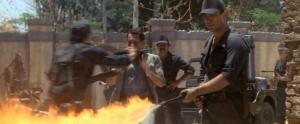
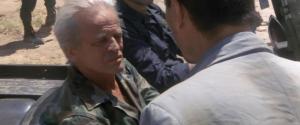
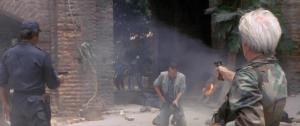
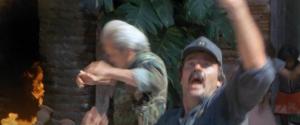 It’s the beginning of the end now as Silveira’s right hand man, the Capitan, gets shot at and then the bloody Casio pan pipes kick in again. The kid drags the Father to safety as Silveira commences what turns out to be a bloodbath shoot out. This is the best bit of the film really but it’s all over in a flash.
It’s the beginning of the end now as Silveira’s right hand man, the Capitan, gets shot at and then the bloody Casio pan pipes kick in again. The kid drags the Father to safety as Silveira commences what turns out to be a bloodbath shoot out. This is the best bit of the film really but it’s all over in a flash.
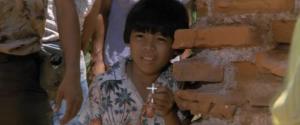
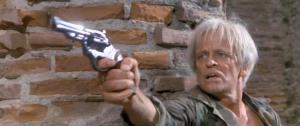
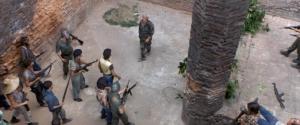 Trigger-happy Silveira soon runs out of bullets and gets cornered by the rebels who start to kick the crap out of him. Carrasco arrives and tries to break it up but he’s arrived too late as Silveira is already dead. That puts an end to it all, except that before the credits can roll we have to go through yet another of those embarrassingly heartfelt moments. This one is an absolute corker – Carrasco tells the Father: “It’s our country again, Julio. We are the future.” The Father dies, probably of embarrassment at the corniness of it all. Then people start banging stuff and I’m not sure why, maybe it is in an attempt to drown out a horrid song called “In The War” – bring back the Casio pan pipes, I say!
Trigger-happy Silveira soon runs out of bullets and gets cornered by the rebels who start to kick the crap out of him. Carrasco arrives and tries to break it up but he’s arrived too late as Silveira is already dead. That puts an end to it all, except that before the credits can roll we have to go through yet another of those embarrassingly heartfelt moments. This one is an absolute corker – Carrasco tells the Father: “It’s our country again, Julio. We are the future.” The Father dies, probably of embarrassment at the corniness of it all. Then people start banging stuff and I’m not sure why, maybe it is in an attempt to drown out a horrid song called “In The War” – bring back the Casio pan pipes, I say!

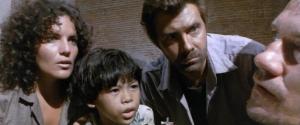 The horror! The horror! Thank goodness, it’s all over now… It’s all over now. But I will, of course, be getting the Arrow Films version of Commando Leopard if it’s the original running time and contains more footage, so let’s hope that it doesn’t, eh?
The horror! The horror! Thank goodness, it’s all over now… It’s all over now. But I will, of course, be getting the Arrow Films version of Commando Leopard if it’s the original running time and contains more footage, so let’s hope that it doesn’t, eh?
Kinski’s acting methods: As ever, Kinski is a sight to behold in this film – he spends some of his time fiddling with his armpits, a lot of time smoking and blowing smoke in people’s faces, and the rest of his time with his hands in his pockets:
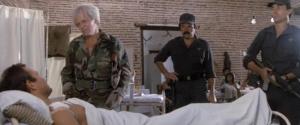
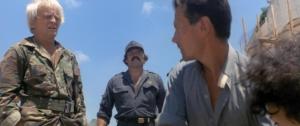


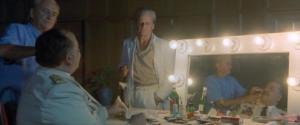 He also manages to stare through a barred window as well:
He also manages to stare through a barred window as well:
Other information about the film: According to IMDB at the time of making Commando Leopard was the most expensive Swiss-budgeted film, with the special effects using up about half of the budget. Christian David says in Kinski die Biographie that Kinski began work on Commando Leopard on 22 April 1985 and was paid $75,000 for two weeks’ filming. The working title of the film was Guerrilleros / Bushfighter.
Regular readers of Du dumme Sau! will already have read my “review” of Kinski Talks 1 and specifically the Wer bin ich? interview with Helga Guitton, accompanied by Hans Leutenegger, to promote Commando Leopard. Klaus didn’t make much effort as far as promotion was concerned – every time Helga asked a question he made every attempt not to answer it or if he did bother to answer he either did so mischievously or with disdain. It has to be seen to be believed, but if your German is basic like mine just read my review (or look at the pictures) here.


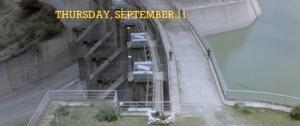
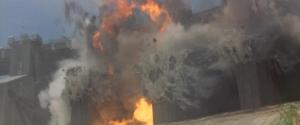

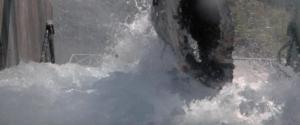
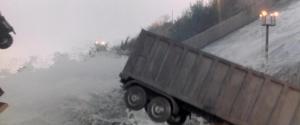
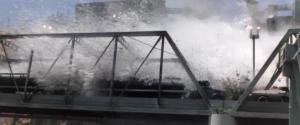

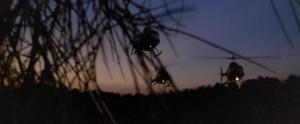
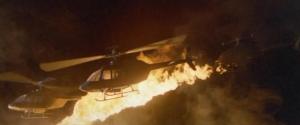
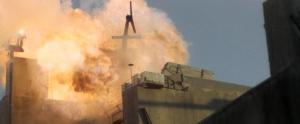

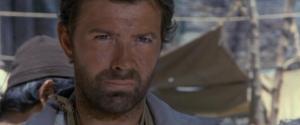
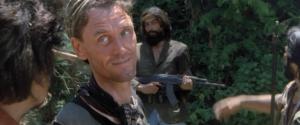
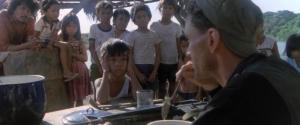
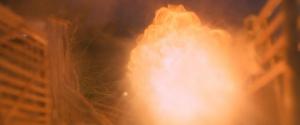
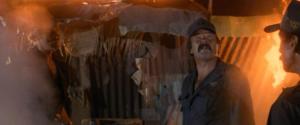
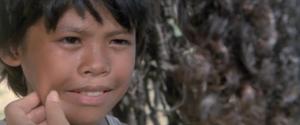
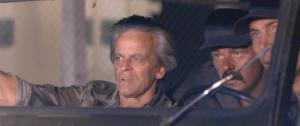
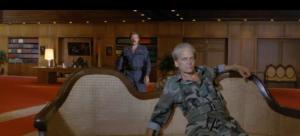
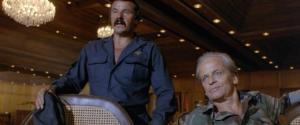
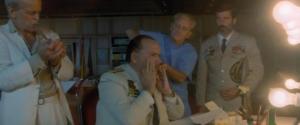
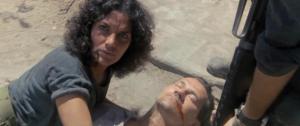
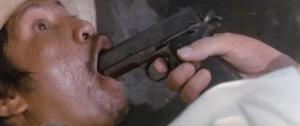
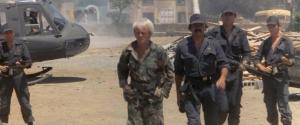
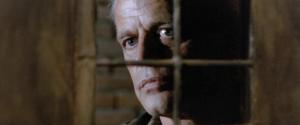
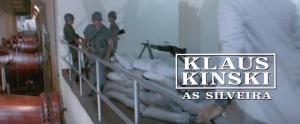
Hello Raechel!
Very entertaining review, but it seems that you have missed one of the best moments from “Commando Leopard”.
It happens shortly after the hospital is set on fire and Carrasco arrives.
When Silveira and the Captain quickly enter the helicopter Kinski, by accident I guess, hits the visor of Leutenegger’s cap, and the cap falls off his head 🙂
On my German DVD the Scene is at 45 minutes and 33 Seconds.
Greetings from Austria,
Markus
Fabulous, Markus! I’m going to dig the DVD out again now and check that out – a comedy moment with Hans Leutenegger is worth enduring Commando Leopard again. Thanks for sharing this and for visiting the site. All the best from Bath, UK. Raechel
Hi Markus! Exactly the same timing on the Anchor Bay version of the DVD (45 mins 33 secs). So funny, I had to rewind it and watch it again. Thanks for telling us about this. R
Glad you enjoyed it!
You seem to like Leutenegger very much, maybe you are interested in his Biographie “Hausi Leutenegger: Ein bisschen Glück war auch dabei”.
The book also covers his relationship to Kinski during the shooting and promotion of “Commando Leopard”.
Thanks, Markus. I shall have to check out the Leutenegger biography at some point. I once emailed him to ask for an interview but he didn’t reply!
If you want I can translate for you the Interview he gives on “Kinski talks 1”.
This should be no big deal, email me if you are interested.
It’s sure a shame that those Kinski-talks DVD’s offer no subtitles for a non-german-speaking audience.
I would love that, please! I’ll email you about it. Thanks for offering. All the best Raechel
Hi there! I have quite a bit of time on my hands- I’m waiting for spring semester to start so I can resume college- so when I found Klaus Kinski’s All I Need is Love at the library I knew I had to preserve it in .pdf form. I’ve never scanned a book before, so while it’s by no means a perfect scan, it’s readable. I put it in .mobi, the kindle e-reader format, as well. Anyone who wants it I’ll gladly give it to as that is why I made the scan. As for issues of piracy and whatnot, I don’t see how that could be a problem as it was pulled from publication- the only people making any money off this book are resellers. (It is the same situation in the UK right?)
Hi! Thanks very much. I’m sure lots of people would be interested but you have to be so careful as KK’s biography belongs to his Estate, I guess. It’s tricky with copyright etc. Stay in touch though as it’s always nice to hear from fellow KK’S fans. All the best. raechel
I imagine. I really don’t know how such things exactly would work. Oh well.
Hi Raechel,
Hate the review, nothing personal I just happen to love the film along with CODENAME WILDGEESE and THE COMMANDER. My partner and son are also fans. Just for the record you state that the music is by Goran Kuzminac, this is true but portions of the soundtrack are from THE BATTLE OF ALGIERS by Ennio Morricone, bit of a cheat by the DVD company but I guess theay are half right. Excellent blog by the way and keep up the good work.
Derrick
Thanks for your comments, Derrick. Yes, it wouldn’t do for us all to be the same. I just don’t like action movies at all. Have you seen The Soldier? My review of that is even worse! Thanks for reading anyway.